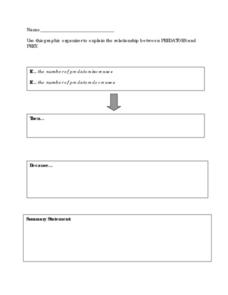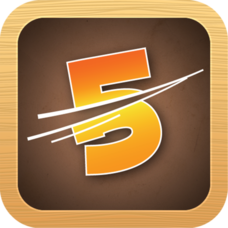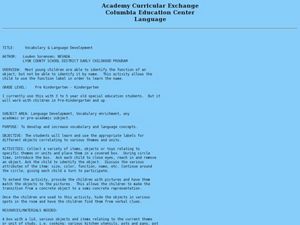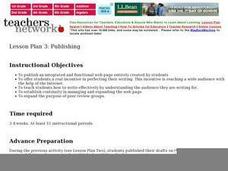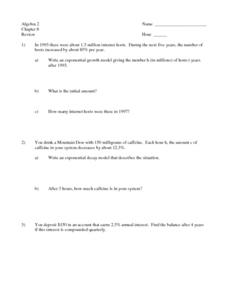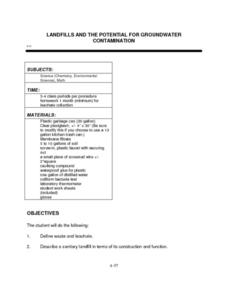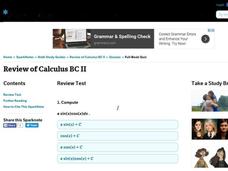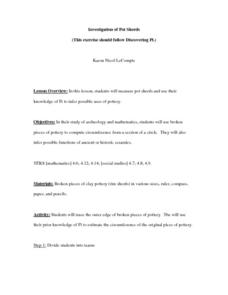Curated OER
Guess My Rule
Young scholars drill on math patterns, functions and Algebra. They construct and use tables to solve problems associated with mathematical relationships and identify a rule/equation. Students comprehend input/output to determine the...
Curated OER
Predators and Prey
Students explain how the food chain works. They contrast predators with prey and describe their function in nature. Students discuss how the food chain aids in keeping nature balanced. In small groups, they play a game that simulates the...
Curated OER
Are You Thirsty? The Effects of Pollution on Drinking Water
Discuss the availability of clean, plentiful water and the causes of water pollution. In groups, sixth graders discuss problem-solving methods for keeping water clean. They explore the function of water treatment plants and perform...
Curated OER
Nervous System
Get to know the body's central nervous system through an engaging game of nervous system telephone. But this isn't your average game of telephone. Here, pupils must find a way to communicate a message to the brain without speaking....
Third Rail Games
Factor Samurai
Master composite and prime numbers with this fast-moving game. Using your sword, slice those composite numbers and watch them break up into factors. Slice again if those factors are composite. However, watch out for prime numbers,...
Curated OER
A Penny Saved is a Penny Earned
Students explore the concept of exponential growth. For this exponential growth lesson, students manipulate power models with base 2. Students discuss what would happen if you doubled a penny over the course of 20 days. ...
Curated OER
Integrated Algebra/Math B Regents Questions: Exponential Equations
In this exponential equations learning exercise, students solve 11 word problems in short answer and multiple choice format. Students write and solve exponential growth and decay problems given a word problem.
Curated OER
Exponential Population Growth
In this exponential population growth worksheet, students read word problems and determine the exponential growth of a specified populations. They find the percent of growth and compute exponential regressions. Students graph...
Radford University
Linear Equations in Real Word Problems
Make up a story about a linear graph. Scholars identify key features of a linear graph, such as intercepts, domain and range, and slope. They then create a word problem that could be represented by the graphed line.
Curated OER
Vocabulary & Language Development
Learners develop their vocabulary skills. In this vocabulary and language lesson plan, students practice naming everyday objects as they take part in 3 classroom activities that require them to note attributes of everyday objects their...
Curated OER
Solving Equations Reducible to Quadratic: Extra Practice 34
In this math worksheet, students solve problems involving radicals in six problems. The other ten problems require students to factor quadratic equations and solve for the given variable. Two problems involve negative exponents.
Curated OER
Math 155 Review Worksheet for Exam 1
In this college level calculus worksheet, students evaluate the given limits or show that the limit does not exist. Students determine the derivative of the given functions. The two page worksheet contains twenty-six...
Curated OER
Lesson Plan 3: Publishing
Students, in groups, publish an integrated and functional web page. They create action plans and establish daily and weekly objectives, and then use cameras and video cameras to tak epictures and short movies of school activities.
Curated OER
Test Your Grammar Skills
In this grammar instructional activity, students complete sentences by inserting the correct "ing" word. Twenty words are given to answer twenty questions.
Curated OER
Chapter 8 Review: Exponential Growth
In this exponential growth worksheet, students find the exponential growth and exponential decay of given situations. They simplify problems with exponents and evaluate logarithms. This four-page worksheet contains 23 multi-step problems.
Curated OER
Muscle Movements
Students participate in a game to identify major muscle groups in the body and gain an understanding of muscle functions.
Curated OER
Ya' Gotta Have Heart
Fourth graders study the parts of the human circulatory system and how they function. They design a flow chart of the circulatory system and use data to construct charts and graphs.
Curated OER
Reproduction and Development
For this development worksheet, high schoolers compare the characteristics of mitosis and meiosis. Students review the male and female reproductive organs and their functions. This worksheet has 4 graphic organizer, 6 short answer, and...
Curated OER
Orienteering II
Students name the parts of a compass and comprehend the function of each part. They define paces and tallies and use them in a real world situation. Students are shown the proper use of radio terminology. They use a map and compass to...
Curated OER
The Drinking Bird
High schoolers discover how toys often illustrate fundamental physical principles. The toy drinking bird is an example. The challenge for you in the lab is to discover why the drinking bird functions.
Curated OER
Landfills and the Potential for Groundwater Contamination
Students examine how a sanitary landfill is constructed, how it functions, and how waste and leachate affects the areas around the landfill. After a discussion about landfills and leachates, students construct a Sanitary Landfill Model...
Curated OER
Review of Calculus BC II
In this Calculus worksheet, learners assess their understanding of various topics, including the derivatives of trigonometric functions, evaluating integrals, sigma notation, and convergent and divergent series. The one page...
Curated OER
Is There a Doctor in the House
Sixth graders predict outcomes of research. They analyze data and construct a class graph, then work cooperatively in a small group setting. They explain the prevention aspect of medicine, document references, and continue ongoing...
Curated OER
Investigating Pot Sherds
Sixth graders measure pot sherds and use their knowledge of Pi to infer possible uses of pottery. They also infer possible functions of ancient ceramics. After tracing rounded pottery pieces onto paper, 6th graders use compasses to...

